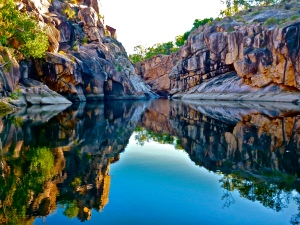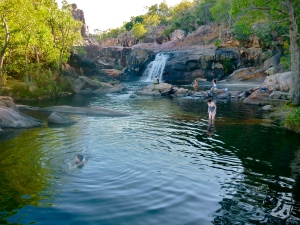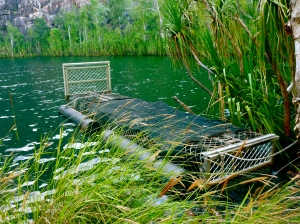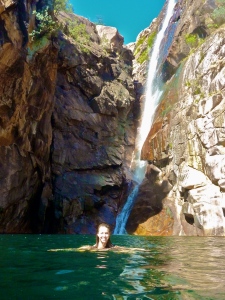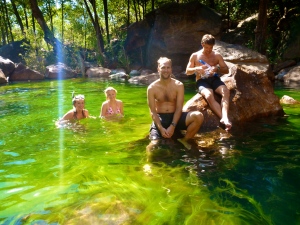The Adventure Tours group was divided in order to fit us onto 2 separate trucks for some off-roading through the National Parks, as well as to accommodate some new passengers. The older Canadian couples were put on the other bus, and we gained a girl from London. Other than that, we remained the same but with our new guide, Luke. Except for our camp spot tonight, we pretty much had the same schedule as the other bus today.
We started our tour in Litchfield National Park with our first stop being the termite mounds. Britt and I passed what seemed like billions of these in Western Australia and were always laughing at the people who stopped to take pictures of them. Now I’ve fallen into the tourist trap as well! Termite mounds can stay active for dozens of years until the queen dies, just building the mounds higher and higher with grass, spit and feces, in such a way that there is minimal surface area exposed when the sun is directly overhead (the hottest part of the day). This keeps the temperature consistently around 30 degrees Celsius. The magnet termites we saw build their mounds high and flat facing within 15 degrees North to South, which gives off an eerie resemblance to gravestones.

magnet termite mounds
From there (and after catching and tasting some ants with green behinds) we drove to Florence Falls. The walk there via the Florence Falls path was 1km, and the walk back via the Shady Creek path was 3km – none too difficult in sandals. The Florence Falls water hole was a popular spot for families this morning with children splashing around some of the lower pools with calm water. Florence held 2 average-sized waterfalls, but combined they made a fairly decent current so that some of the weaker swimmers were unable to swim to the rocks between them. Some of us attempted to climb these rocks for some fun jumps and pictures, and some of us (ahem, just myself) slipped while jumping. If ever I was to slip, this was the perfect place as there were no rocks underneath… but it was still slightly embarrassing!

Florence Falls
We swam around here for the better half of an hour, warming up (or really, waking up) for our day.

Florence Falls plunge pool
The Buley Rock Falls was our next destination, only a few short minutes drive away. Again, this was a popular spot for families and backpackers alike. The stream dropped from one pool to another in a continuous winding path. I worked my way down to one of the lower pools where some people from the other bus were cannon-balling in and confirmed that it was fairly deep. Our group spent another half hour swimming around here, testing all the various levels of freshwater pools, drifting in their currents, and diving to their depths.

Buley Rocks Falls
This completed our tour of Litchfield National Park, and we headed on toward the Window of the Wetlands in Humpty Do. Here, we received an informational from the leader of the aboriginal country, Jawoyn, in the southern region of Kakadu. He showed us the different types of woods used for making didgeridoos, as well as how to look for the hollowed center by that of a termite (rather than a forced drill) for a better sound. I was rather pathetic at playing it, but I managed to squeeze out an elephant-like sound from the instrument so I wasn’t a total failure. After this demonstration, the leader’s daughter showed us the hobbies taken on by the women in the tribe. Whereas her father spoke very quickly and was often difficult to understand, she was surprisingly very well spoken, especially at her age! You could tell her parents took great care in teaching her all the history and culture of their aboriginal ways as well as focusing on the importance of effectively communicating it to people outside their community. I was very impressed! She showed us the methodology of dilly bag (purse) and basket weaving, as well as extracting dyes from the earth. Such tedious work! Most of the pieces she showed us took over 6 months to create.

Aboriginal dilly bags and place mats
Following these demonstrations, we took the more outdoors-y route to Corroboree Billabong for a crocodile cruise! Apparently they used to have these cruises in the Yellow Water region, home to the “world-famous” wetlands, but this one was so much better that they scratched that one entirely. Crocodiles are the world’s largest living reptiles, and also one of the oldest, having existed unchanged for about 200 million years. Though the billabong is freshwater, most of the crocs we saw were estuarine (saltwater) crocs, or “salties.” Freshwater crocs, or “freshies,” have long, thin faces with a sort of bulb on the tip of their snout, and can only found in Australia. They only grow to be up to 3m and are not considered dangerous to humans unless you approach them. They prey on smaller birds, fish and frogs, but their bite would still be very painful for a human – just not life-threatening. Salties on the other hand can grow to be 9m long and their short, wide, rounded snouts can exert a great amount of pressure. These are aggressive creatures and considered extremely dangerous to humans, as they will grab you and drag you underwater as their prey if given the opportunity. Yikes! We’re safe inside the boat though.

crocodile in the water!

Allen and the salty
Other areas of the park are designated as “crocodile management zones” in which park rangers trap and remove any salties that moved inward during the wet season. Only until they have been safely removed will these park zones open for visitors at the beginning of the dry season. Even then, traps remain just in case other salties find their way into the area throughout the length of the dry season.
In addition to crocs, we also saw heaps of unusual birds including sea eagles, storks, cranes and ducks. In particular, we were lucky to see the jabiru, which is the largest and only stork in Australia, as well as the night herron, which usually shy away from people and are more active at night.

white-breasted sea eagle

wild jabiru
Gorgeous cruise! Afterwards we parted ways with the other bus and headed toward our own campsite at Bark Hut, where we dined on Kangaroo steaks before building our fire and then heading to bed.
Tags: Australia, ecotourism, Florence Falls, Kakadu National Park, Litchfield National Park, National park, Northern Territory, Outback, Termite, Travel
